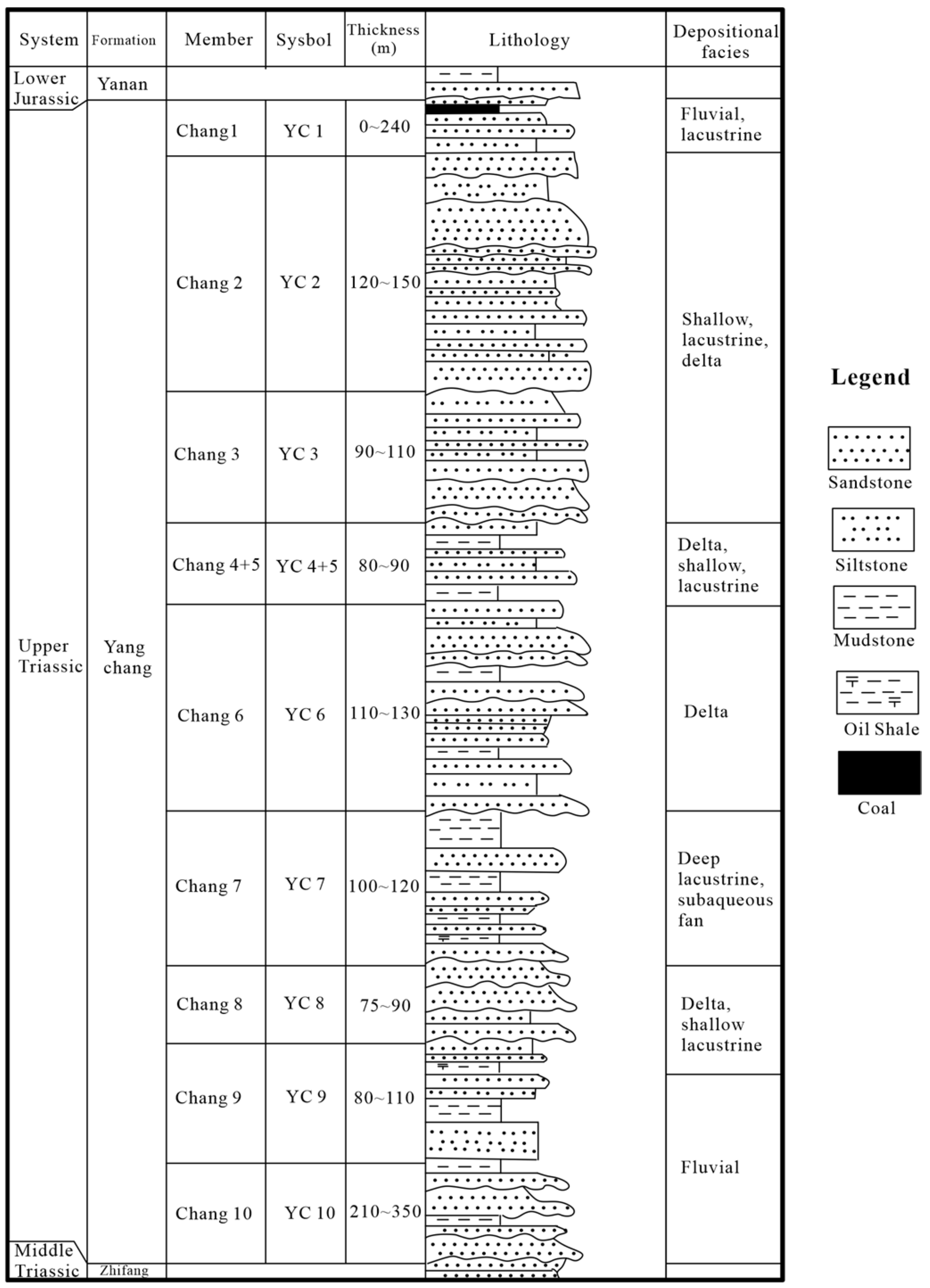Reservoir Petrofacies Predicted Using Logs Data: A Study of Shale Oil from Seven Members of the Upper Triassic Yanchang Formation, Ordos Basin, China
Abstract
:1. Introduction
2. Geological Background
3. Materials and Methods
3.1. Materials and Experiments
3.2. The Multi-Resolution Graph-Based Clustering (MRGC) Algorithms
4. Results
4.1. Petrofacies
4.2. Electrofacies
4.2.1. Electrofacies from Interpreted Logs
4.2.2. Electrofacies from Raw Well Logs
5. Discussion
6. Conclusions
Author Contributions
Funding
Data Availability Statement
Acknowledgments
Conflicts of Interest
References
- Yang, R.; Yin, W.; Fan, A.; Han, Z. Fine-Grained, Lacustrine Gravity-Flow Deposits and Their Hydrocarbon Significance in the Triassic Yanchang Formation in Southern Ordos Basin. J. Palaeogeogr. 2017, 19, 791–806, (In Chinese, with English Abstract). [Google Scholar] [CrossRef]
- Cao, B.; Sun, W.; Li, J. Reservoir Petrofacies—A Tool for Characterization of Reservoir Quality and Pore Structures in a Tight Sandstone Reservoir: A Study from the Sixth Member of Upper Triassic Yanchang Formation, Ordos Basin, China. J. Pet. Sci. Eng. 2021, 199, 108294. [Google Scholar] [CrossRef]
- Cao, B.; Luo, X.; Zhang, L.; Lei, Y.; Zhou, J. Petrofacies Prediction and 3-D Geological Model in Tight Gas Sandstone Reservoirs by Integration of Well Logs and Geostatistical Modeling. Mar. Pet. Geol. 2020, 114, 104202. [Google Scholar] [CrossRef]
- Li, B.; Pang, X.; Dong, Y.; Peng, J.; Gao, P.; Wu, H.; Huang, C.; Shao, X. Lithofacies and Pore Characterization in an Argillaceous-Siliceous-Calcareous Shale System: A Case Study of the Shahejie Formation in Nanpu Sag, Bohai Bay Basin, China. J. Pet. Sci. Eng. 2019, 173, 804–819. [Google Scholar] [CrossRef]
- Jafarzadeh, N.; Kadkhodaie, A.; Ahmad, B.J.; Kadkhodaie, R.; Karimi, M. Identification of Electrical and Petrophysical Rock Types Based on Core and Well Logs: Utilizing the Results to Delineate Prolific Zones in Deep Water Sandy Packages from the Shah Deniz Gas Field in the South Caspian Sea Basin. J. Nat. Gas Sci. Eng. 2019, 69, 102923. [Google Scholar] [CrossRef]
- Ros De, L.F.; Goldberg, K. Reservoir Petrofacies: A Tool for Quality Characterization and Predictions. In Proceedings of the AAPG Annual Convention, Long Beach, CA, USA, 1–4 April 2007. [Google Scholar]
- Trop, T.M.; Ridgway, K.D. Petrofacies and Provenance of a Late Cretaceous Suture Zone Thrust-Top Basin, Cantwell Basin, Central Alaska Range. J. Sediment. Res. 1997, 67, 469–485. [Google Scholar]
- Silva, A.; Tavares, M.; Carrasquilla, A.; Missagia, R.; Ceia, M. Petrofacies Classification Using Machine Learning Algorithms. Geophysics 2020, 85, WA101–WA113. [Google Scholar] [CrossRef]
- Glover, P.W.J.; Mohammed-Sajed, O.K.; Akyüz, C.; Lorinczi, P.; Collier, R. Clustering of Facies in Tight Carbonates Using Machine Learning. Mar. Pet. Geol. 2022, 144, 105828. [Google Scholar] [CrossRef]
- Wang, M.; Yang, J.; Wang, X.; Li, J.; Xu, L.; Yan, Y. Identification of Shale Lithofacies by Well Logs Based on Random Forest Algorithm. Earth Sci. 2023, 48, 130–142. [Google Scholar] [CrossRef]
- Al-Mudhafar, W.J. Integrating Component Analysis & Classification Techniques for Comparative Prediction of Continuous & Discrete Lithofacies Distributions. In Proceedings of the Offshore Technology Conference, Houston, TX, USA, 2–5 May 2015; p. OTC-25806-MS. [Google Scholar]
- Liu, B.; Shi, J.; Fu, X.; Lyu, Y.; Sun, X.; Gong, L.; Bai, Y. Petrological Characteristics and Shale Oil Enrichment of Lacustrine Fine-Grained Sedimentary System: A Case Study of Organic-Rich Shale in First Member of Cretaceous Qingshankou Formation in Gulong Sag, Songliao Basin, NE China. Pet. Explor. Dev. 2018, 45, 884–894. [Google Scholar] [CrossRef]
- Wang, G.; Carr, T. Organic-Rich Marcellus Shale Lithofacies Modeling and Distribution Pattern Analysis in the Appalachian Basin. AAPG Bull. 2013, 97, 2173–2205. [Google Scholar] [CrossRef]
- Atchley, S.; Crass, B.; Prince, K. The Prediction of Organic-Rich Reservoir Facies within the Late Pennsylvanian Cline Shale (Also Known as Wolfcamp D), Midland Basin, Texas. AAPG Bull. 2021, 105, 29–52. [Google Scholar] [CrossRef]
- Venieri, M.; Harazim, D.; Pedersen, P.K.; Eaton, D.W. Vertical and Lateral Facies Variability in Organic-Rich Mudstones at the Reservoir Scale: A Case Study from the Devonian Duvernay Formation of Alberta, Canada. Mar. Pet. Geol. 2021, 132, 105232. [Google Scholar] [CrossRef]
- Gifford, C.M.; Agah, A. Collaborative Multi-Agent Rock Facies Classification from Wireline Well Log Data. Eng. Appl. Artif. Intell. 2010, 23, 1158–1172. [Google Scholar] [CrossRef]
- Al-Mudhafar, W.J.; Al Lawe, E.M.; Noshi, C.I. Clustering Analysis for Improved Characterization of Carbonate Reservoirs in a Southern Iraqi Oil Field; OnePetro: Richardson, TX, USA, 2019. [Google Scholar]
- Witten, I.H.; Frank, E.; Hall, H. Data Mining: Practical Machine Learning Tools and Techniques; Morgan Kaufmann: New Brunswick, NJ, USA, 2011; ISBN 978-0-12-374856-0. [Google Scholar]
- Han, R.; Wang, Z.; Guo, Y.; Wang, X.; A, R.; Zhong, G. Multi-Label Prediction Method for Lithology, Lithofacies and Fluid Classes Based on Data Augmentation by Cascade Forest. Adv. Geo-Energy Res. 2023, 9, 25–37. [Google Scholar] [CrossRef]
- Pabakhsh, M.; Ahmadi, K.; Riahi, M.A.; Shahri, A.A. Prediction of PEF and LITH Logs Using MRGC Approach. Life Sci. J. 2012, 9, 974–982. [Google Scholar]
- Khoshbakht, F.; Mohammadnia, M. Assessment of Clustering Methods for Predicting Permeability in a Heterogeneous Carbonate Reservoir. In Proceedings of the 4th International Conference and Exhibition: New Discoveries through Integration of Geosciences, Saint Petersburg, Russia, 5–8 April 2010. [Google Scholar] [CrossRef]
- Nouri-Taleghani, M.; Kadkhodaie, A.; Karimi-Khaledi, M. Determining Hydraulic Flow Units Using a Hybrid Neural Network and Multi-Resolution Graph-Based Clustering Method: Case Study from South Pars Gasfield, Iran. J. Pet. Geol. 2015, 38, 177–191. [Google Scholar] [CrossRef]
- Tian, Y.; Xu, H.; Zhang, X.-Y.; Wang, H.-J.; Guo, T.-C.; Zhang, L.-J.; Gong, X.-L. Multi-Resolution Graph-Based Clustering Analysis for Lithofacies Identification from Well Log Data: Case Study of Intraplatform Bank Gas Fields, Amu Darya Basin. Appl. Geophys. 2016, 13, 598–607. [Google Scholar] [CrossRef]
- Sutadiwiria, Y. Using MRGC (Multi-Resolution Graph-Based Clustering) Method to Integrate Log Data and Core Facies to Diffine Electrofacies, in the Benua Field, Central Sumatera Basin, Indonesia. In Proceedings of the International Gas Union Research Conference, Paris, France, 8–10 October 2008; pp. 733–744. [Google Scholar]
- Zhao, W.; Hu, S.; Hou, L.; Yang, T.; Li, X.; Guo, B.; Yang, Z. Types and Resource Potential of Continental Shale Oil in China and Its Boundary with Tight Oil. Pet. Explor. Dev. 2020, 47, 1–11. [Google Scholar] [CrossRef]
- Yang, H.; Deng, X. Deposition of Yanchang Formation Deep-Water Sandstone under the Control of Tectonic Events, Ordos Basin. Pet. Explor. Dev. 2013, 40, 549–557. [Google Scholar] [CrossRef]
- Dong, Y.; Liu, X.; Zhang, G.; Chen, Q.; Zhang, X.; Li, W.; Yang, C. Triassic Diorites and Granitoids in the Foping Area: Constraints on the Conversion from Subduction to Collision in the Qinling Orogen, China. J. Asian Earth Sci. 2012, 47, 123–142. [Google Scholar] [CrossRef]
- Yang, R.; Jin, Z.; Han, Z.; Fan, A. Climatic and Tectonic Controls of Lacustrine Hyperpycnite Origination in the Late Triassic Ordos Basin, Central China: Implications for Unconventional Petroleum Development. AAPG Bull. 2017, 101, 95–117. [Google Scholar] [CrossRef]
- Zou, C.; Wang, L.; Li, Y.; Tao, S.; Hou, L. Deep-Lacustrine Transformation of Sandy Debrites into Turbidites, Upper Triassic, Central China. Sediment. Geol. 2012, 265–266, 143–155. [Google Scholar] [CrossRef]
- Chen, S.; Yu, H.; Lu, M.; Lebedev, M.; Li, X.; Yang, Z.; Cheng, W.; Yuan, Y.; Ding, S.; Johnson, L. A New Approach to Calculate Gas Saturation in Shale Reservoirs. Energy Fuels 2022, 36, 1904–1915. [Google Scholar] [CrossRef]
- Liu, M.; Gluyas, J.; Wang, W.; Liu, Z.; Liu, J.; Tan, X.; Zeng, W.; Xiong, Y. Tight Oil Sandstones in Upper Triassic Yanchang Formation, Ordos Basin, N. China: Reservoir Quality Destruction in a Closed Diagenetic System. Geol. J. 2019, 54, 3239–3256. [Google Scholar] [CrossRef]
- Yang, H.; Fu, J.; He, H.; Liu, X.; Zhang, Z.; Deng, X. Formation and Distribution of Large Low-Permeability Lithologic Oil Regions in Huaqing, Ordos Basin. Pet. Explor. Dev. 2012, 39, 683–691. [Google Scholar] [CrossRef]
- Zhang, W.; YANG, H.; Yang, W.; Wu, K.; Liu, F. Assessment of geological characteristics of lacustrine shale oil reservoir in Chang7 Member of Yanchang Formation, Ordos Basin. Geochimica 2015, 44, 505–515. [Google Scholar] [CrossRef]
- Zhao, J.; Mountney, N.P.; Liu, C.; Qu, H.; Lin, J. Outcrop Architecture of a Fluvio-Lacustrine Succession: Upper Triassic Yanchang Formation, Ordos Basin, China. Mar. Pet. Geol. 2015, 68, 394–413. [Google Scholar] [CrossRef]
- Monshi, A.; Foroughi, M.R.; Monshi, M. Modified Scherrer Equation to Estimate More Accurately Nano-Crystallite Size Using XRD. World J. Nano Sci. Eng. 2012, 2, 154–160. [Google Scholar] [CrossRef]
- Ye, S.-J.; Rabiller, P. A New Tool for Electro-Facies Analysis: Multi-Resolution Graph-Based Clustering. In Proceedings of the SPWLA 41st Annual Logging Symposium, Dallas, TX, USA, 4–7 June 2000. [Google Scholar]
- Movahhed, A.; Bidhendi, M.N.; Masihi, M.; Emamzadeh, A. Introducing a Method for Calculating Water Saturation in a Carbonate Gas Reservoir. J. Nat. Gas Sci. Eng. 2019, 70, 102942. [Google Scholar] [CrossRef]
- Kang, Y.; Shang, C.; Zhou, H.; Huang, Y.; Zhao, Q.; Deng, Z.; Wang, H.; Ma, Y.Z. Mineralogical Brittleness Index as a Function of Weighting Brittle Minerals—From Laboratory Tests to Case Study. J. Nat. Gas Sci. Eng. 2020, 77, 103278. [Google Scholar] [CrossRef]
- Yu, H.; Rezaee, R.; Wang, Z.; Han, T.; Zhang, Y.; Arif, M.; Johnson, L. A New Method for TOC Estimation in Tight Shale Gas Reservoirs. Int. J. Coal Geol. 2017, 179, 269–277. [Google Scholar] [CrossRef]
- Yu, H.; Wang, Z.; Rezaee, R.; Zhang, Y.; Han, T.; Arif, M.; Johnson, L. Porosity Estimation in Kerogen-Bearing Shale Gas Reservoirs. J. Nat. Gas Sci. Eng. 2018, 52, 575–581. [Google Scholar] [CrossRef]
- Yu, H.; Zhenliang, W.; Cheng, H.; Yin, Q.; Fan, B.; Qin, X.; Luo, X.; Wang, X.; Zhang, L. An Identified Method for Lacustrine Shale Gas Reservoir Lithofacies Using Logs: A Case Study for No. 7 Section in Yanchang Formation in Ordos Basin. Open Pet. Eng. J. 2015, 8, 297–307. [Google Scholar] [CrossRef]
- Porras, J.C.; Barbato, R.; Khazen, L. Reservoir Flow Units: A Comparison Between Three Different Models in the Santa Barbara and Pirital Fields, North Monagas Area, Eastern Venezuela Basin. In Proceedings of the Latin American and Caribbean Petroleum Engineering Conference, Caracas, Venezuela, 21–23 April 1999; p. SPE-53671-MS. [Google Scholar]
- Rushing, J.A.; Newsham, K.E.; Blasingame, T.A. Rock Typing—Keys to Understanding Productivity in Tight Gas Sands. In Proceedings of the SPE Unconventional Reservoirs Conference, Keystone, CO, USA, 10–12 February 2008; p. SPE-114164-MS. [Google Scholar]
- Tobin, R.; Mcclain, T.; Lieber, R.; Ozkan, A.; Banfield, L.; Marchand, A.; McRae, L. Reservoir Quality Modeling of Tight-Gas Sands in Wamsutter Field: Integration of Diagenesis, Petroleum Systems, and Production Data. AAPG Bull. 2010, 94, 1229–1266. [Google Scholar] [CrossRef]
- Merletti, G.D.; Spain, D.R.; Melick, J.; Armitage, P.; Hamman, J.; Shabro, V.; Gramin, P. Integration of Depositional, Petrophysical, and Petrographic Facies for Predicting Permeability in Tight Gas Reservoirs. Interpretation 2017, 5, SE29–SE41. [Google Scholar] [CrossRef]
- Wang, F.P.; Reed, R.M.; John, A.; Katherine, G. Pore Networks and Fluid Flow in Gas Shales. In Proceedings of the SPE Annual Technical Conference and Exhibition, New Orleans, LA, USA, 4–7 October 2009; p. SPE-124253-MS. [Google Scholar]
- Ross, D.J.K.; Marc Bustin, R. The Importance of Shale Composition and Pore Structure upon Gas Storage Potential of Shale Gas Reservoirs. Mar. Pet. Geol. 2009, 26, 916–927. [Google Scholar] [CrossRef]
- Passey, Q.R.; Bohacs, K.M.; Esch, W.L.; Klimentidis, R.; Sinha, S. From Oil-Prone Source Rock to Gas-Producing Shale Reservoir—Geologic and Petrophysical Characterization of Unconventional Shale-Gas Reservoirs. In Proceedings of the International Oil and Gas Conference and Exhibition in China, Beijing, China, 8–10 June 2010; p. SPE-131350-MS. [Google Scholar]
- Wang, H.; Lu, S.; Qiao, L.; Chen, F.; He, X.; Gao, Y.; Mei, J. Unsupervised Contrastive Learning for Few-Shot TOC Prediction and Application. Int. J. Coal Geol. 2022, 259, 104046. [Google Scholar] [CrossRef]
- Sone, H.; Zoback, M.D. Mechanical Properties of Shale-Gas Reservoir Rocks—Part 1. Geophysics 2013, 78, D378–D389. [Google Scholar]
- Yu, H.; Lebedev, M.; Zhou, J.; Lu, M.; Li, X.; Wang, Z.; Han, T.; Zhang, Y.; Johnson, L.M.; Iglauer, S. The Rock Mechanical Properties of Lacustrine Shales: Argillaceous Shales versus Silty Laminae Shales. Mar. Pet. Geol. 2022, 141, 105707. [Google Scholar] [CrossRef]
- Yu, H.; Zhang, Y.; Lebedev, M.; Wang, Z.; Li, X.; Squelch, A.; Verrall, M.; Iglauer, S. X-Ray Micro-Computed Tomography and Ultrasonic Velocity Analysis of Fractured Shale as a Function of Effective Stress. Mar. Pet. Geol. 2019, 110, 472–482. [Google Scholar] [CrossRef]
- Liu, M.; Hu, S.; Zhang, J.; Zou, Y. Methods for Identifying Complex Lithologies from Log Data Based on Machine Learning. Unconv. Resour. 2023, 3, 20–29. [Google Scholar] [CrossRef]
- Shoghi, J.; Bahramizadeh-Sajjadi, H.; Nickandish, A.B.; Abbasi, M. Facies Modeling of Synchronous Successions—A Case Study from the Mid-Cretaceous of NW Zagros, Iran. J. Afr. Earth Sci. 2020, 162, 103696. [Google Scholar] [CrossRef]
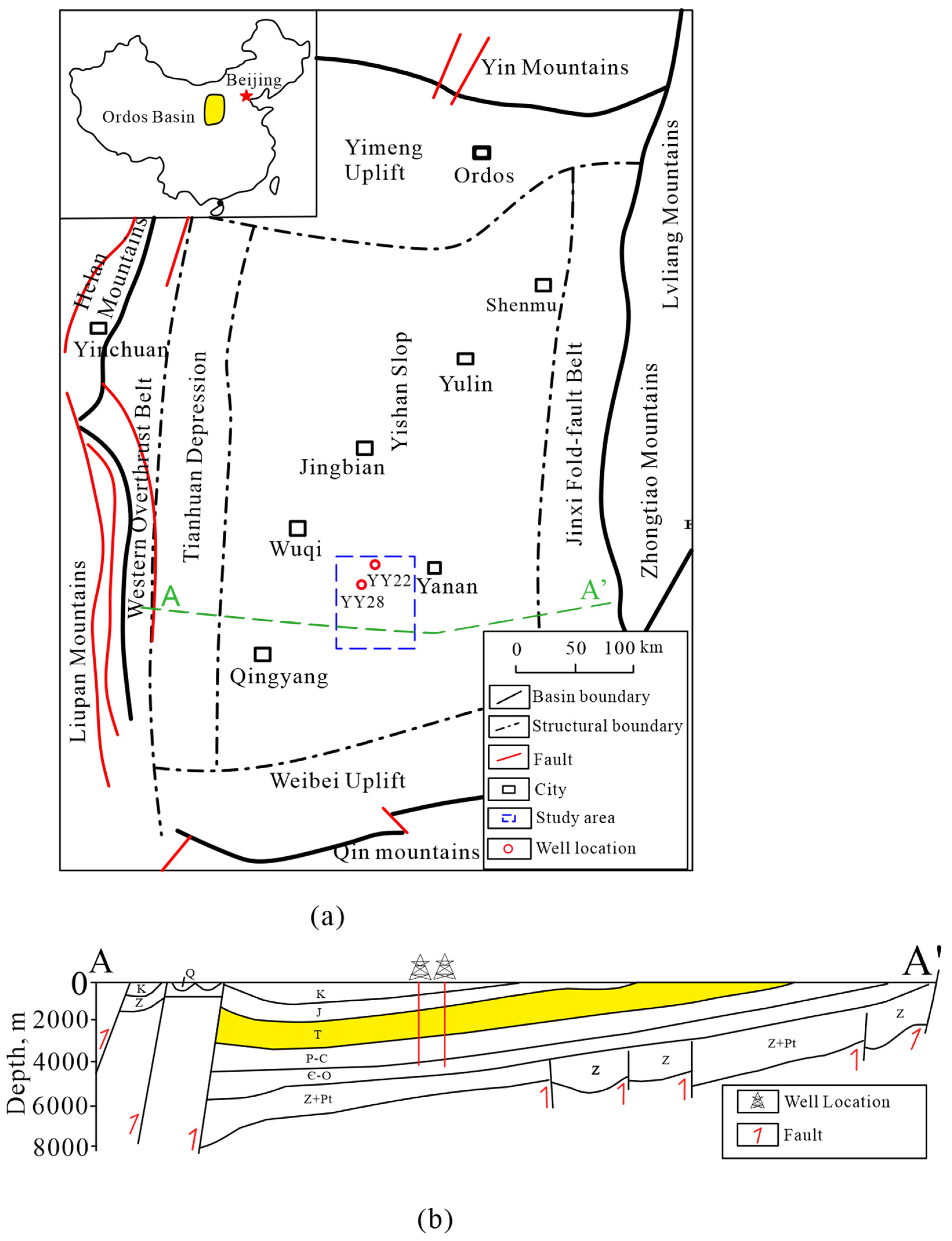




| NO. | POR (%) | TOC (%) | BIbm (%) | PF | NO. | POR (%) | TOC (%) | BIbm (%) | PF |
|---|---|---|---|---|---|---|---|---|---|
| 1 | 1.25 | 1.44 | 36.28 | PF D | 25 | 1.86 | 3.59 | 29.43 | PF D |
| 2 | 1.77 | 3.21 | 36.67 | PF D | 26 | 2.33 | 3.16 | 29.87 | PF D |
| 3 | 0.68 | 3.45 | 28.81 | PF D | 27 | 1.79 | 3.87 | 24.82 | PF D |
| 4 | 0.70 | 2.84 | 29.29 | PF D | 28 | 1.40 | 2.68 | 24.33 | PF D |
| 5 | 0.96 | 1.48 | 43.85 | PF D | 29 | 0.39 | 2.12 | 20.89 | PF D |
| 6 | 2.03 | 3.75 | 26.75 | PF B | 30 | 1.15 | 0.88 | 50.67 | PF D |
| 7 | 1.47 | 4.12 | 24.21 | PF B | 31 | 1.15 | 0.88 | 32.503 | PF C |
| 8 | 1.87 | 4.77 | 25.21 | PF D | 32 | 1.40 | 4.89 | 33.917 | PF C |
| 9 | 2.08 | 4.43 | 34.12 | PF B | 33 | 1.80 | 6.11 | 26.619 | PF C |
| 10 | 2.58 | 2.89 | 34.38 | PF B | 34 | 1.10 | 5.22 | 22.703 | PF B |
| 11 | 1.61 | 4.93 | 27.19 | PF C | 35 | 1.70 | 5.16 | 30.889 | PF B |
| 12 | 2.12 | 4.55 | 25.73 | PF B | 36 | 1.90 | 7.26 | 24.224 | PF C |
| 13 | 1.61 | 4.18 | 32.19 | PF B | 37 | 0.90 | 7.93 | 21.579 | PF B |
| 14 | 1.05 | 3.34 | 30.78 | PF D | 38 | 1.90 | 3.11 | 38.167 | PF D |
| 15 | 2.24 | 2.9 | 25.77 | PF A | 39 | 1.40 | 6.19 | 10.254 | PF C |
| 16 | 1.82 | 3.23 | 30.66 | PF A | 40 | 3.70 | 9.19 | 38.946 | PF B |
| 17 | 1.91 | 4.49 | 27.82 | PF A | 41 | 1.40 | 7.87 | 23.333 | PF B |
| 18 | 1.56 | 5.61 | 31.22 | PF B | 42 | 2.10 | 6.38 | 28.549 | PF B |
| 19 | 2.12 | 5.19 | 27.84 | PF C | 43 | 1.50 | 5.2 | 29.125 | PF D |
| 20 | 1.87 | 3.74 | 25.5 | PF C | 44 | 2.00 | 6.7 | 22.759 | PF C |
| 21 | 2.19 | 4.92 | 21.33 | PF C | 45 | 1.60 | 6.62 | 17.123 | PF B |
| 22 | 1.48 | 5.38 | 28.31 | PF B | 46 | 2.60 | 7.03 | 26.764 | PF B |
| 23 | 1.56 | 5.97 | 37.2 | PF C | 47 | 1.50 | 6.13 | 33.026 | PF D |
| 24 | 1.95 | 2.29 | 36.84 | PF C | 48 | 1.70 | 3.2 | 26.964 | PF D |
| Petrofacies | Characterization | SEM | XRD |
|---|---|---|---|
| PF A | High porosity, high TOC, and high brittleness index; clay mineral interlayer pores and fractures, and interparticle pores. | 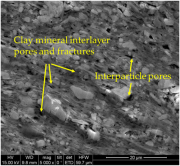 | 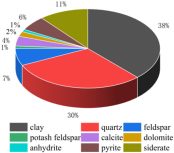 |
| PF B | Median porosity, median TOC, and high brittleness index; interparticle pores and intraparticle pores. |  |  |
| PF C | Low porosity, median TOC, and low brittleness index; clay mineral interlayer pores and fractures, and sparsely developed interparticle and intraparticle pores. | 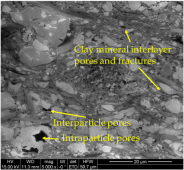 |  |
| PF D | Ultra-low porosity, low TOC, and high brittleness index; clay mineral interlayer pores and fractures. | 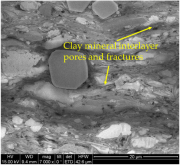 | 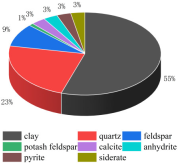 |
Disclaimer/Publisher’s Note: The statements, opinions and data contained in all publications are solely those of the individual author(s) and contributor(s) and not of MDPI and/or the editor(s). MDPI and/or the editor(s) disclaim responsibility for any injury to people or property resulting from any ideas, methods, instructions or products referred to in the content. |
© 2023 by the authors. Licensee MDPI, Basel, Switzerland. This article is an open access article distributed under the terms and conditions of the Creative Commons Attribution (CC BY) license (https://creativecommons.org/licenses/by/4.0/).
Share and Cite
Meng, K.; Wang, M.; Zhang, S.; Xu, P.; Ji, Y.; Meng, C.; Zhan, J.; Yu, H. Reservoir Petrofacies Predicted Using Logs Data: A Study of Shale Oil from Seven Members of the Upper Triassic Yanchang Formation, Ordos Basin, China. Processes 2023, 11, 3131. https://doi.org/10.3390/pr11113131
Meng K, Wang M, Zhang S, Xu P, Ji Y, Meng C, Zhan J, Yu H. Reservoir Petrofacies Predicted Using Logs Data: A Study of Shale Oil from Seven Members of the Upper Triassic Yanchang Formation, Ordos Basin, China. Processes. 2023; 11(11):3131. https://doi.org/10.3390/pr11113131
Chicago/Turabian StyleMeng, Kun, Ming Wang, Shaohua Zhang, Pengye Xu, Yao Ji, Chaoyang Meng, Jie Zhan, and Hongyan Yu. 2023. "Reservoir Petrofacies Predicted Using Logs Data: A Study of Shale Oil from Seven Members of the Upper Triassic Yanchang Formation, Ordos Basin, China" Processes 11, no. 11: 3131. https://doi.org/10.3390/pr11113131
APA StyleMeng, K., Wang, M., Zhang, S., Xu, P., Ji, Y., Meng, C., Zhan, J., & Yu, H. (2023). Reservoir Petrofacies Predicted Using Logs Data: A Study of Shale Oil from Seven Members of the Upper Triassic Yanchang Formation, Ordos Basin, China. Processes, 11(11), 3131. https://doi.org/10.3390/pr11113131





